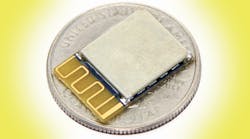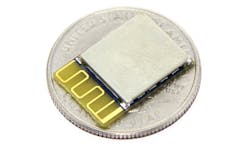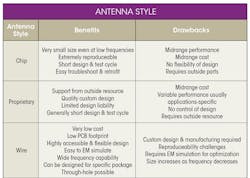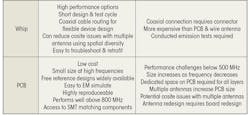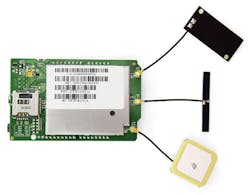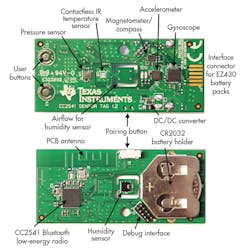Download this article in .PDF format
Modules for Internet of Things (IoT) applications are swarming the consumer and industrial markets with the aim of sensing, computing, and connecting all things within reach. A wealth of clever strategies is needed to shrink the size of these devices while maintaining highly reliable remote performance under low-power conditions. As a result, IoT-module antenna designers face the restrictions of maintaining reasonable performance in ever-shrinking footprints and under extreme interference/cosite conditions (see "To Balun or not to Balun?").
Weighing cost, size, design effort, and manufacturing complexity, IoT modules make an engineer’s design decisions much more challenging. Common IoT antenna typologies range from printed circuit board (PCB) designs to prefabricated chip antennas. The following antenna typologies each have their benefits and drawbacks, which we’ve listed to aid IoT module designers in making the right antenna decision for their applications (see the table).
Chip Antennas
For the smallest form factors--even at low frequencies--chip antennas may be the best option for an ultra-crammed design. In addition to reducing the design effort required to implement an IoT solution, chip antennas could aid in maintaining low reproducibility issues when large manufacturing runs are required. However, chip antennas do add cost and design considerations.
For example, they have lower efficiency and lower bandwidths than other antenna typologies at comparable frequencies. And even if they have internal matching, external matching circuitry is most likely required to achieve datasheet performance. Chip antennas also can be sensitive to groundplane geometries. Given these points, it is crucial to adhere to the documented design guidelines for the chip antenna.
Proprietary Antennas
Proprietary antenna designs are owned by a designer or design company. Occasionally, these antennas also can be commissioned or custom-designed for specific applications. The cost for these antennas begins with the purchasing of the intellectual property (IP), although this option usually comes with support from the antenna design company. For companies that do not have antenna design expertise in house, this design-sourcing option offers a chance to leverage the expertise of highly specialized designers skilled in this area. When considering proprietary antennas, it’s critical to know the exact use case for the antenna. It is then possible to describe and design for the complete performance dynamics.
Wire Antennas
As one of the lowest-cost and highest-flexibility options, wired antennas can be applied to the majority of thrifty designs. Yet they do require additional design effort. These antennas generally demand electromagnetic (EM) simulation for optimal designs. They may even require custom designs based on the module’s housing. Wired antennas also increase in size as frequency decreases, which may add to the manufacturing challenges associated with design reproducibility and reliability. If a talented CAD and EM simulation designer is available, however, it is possible to create space-saving routing through a module’s housing. An added benefit of a wired antenna is that prototyping is generally very cost-effective. Many antenna designs can be tested with little lead time.
Whip Antennas
Whip antennas are one of the highest-cost antenna options. Yet they also are the highest-performing and may be the best fit if the module faces cosite issues with multiple transceivers. In addition to the up-front antenna cost, a connector will be needed on board. The design also will have to account for coaxial cable routing from the launching connector to the antenna module. For many whip antennas, emissions testing also will need to be performed.
